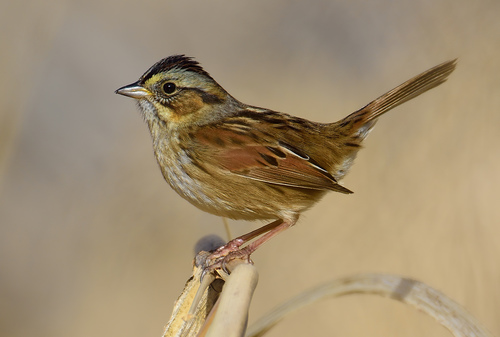
Swamp Sparrow
The Swamp Sparrow (Melospiza georgiana) is a medium-sized sparrow native to North America. It is known for its distinctive, rich, and somewhat musical trill, often heard in wetland habitats. This bird plays a crucial role in its ecosystem, primarily as an insectivore during the breeding season, helping to control insect populations, and as a seed disperser during the winter months. While not as visually striking as some other sparrow species, its subtle beauty and unique vocalizations make it a favorite among birdwatchers. Culturally, the Swamp Sparrow is less prominent than some other birds but is often associated with the tranquility and biodiversity of wetland environments.
12-15 cm
Length
18-21 cm
Wingspan
Least Concern
Conservation Status
Distribution
The Swamp Sparrow breeds across the northeastern United States and Canada, extending south along the Atlantic coast to the mid-Atlantic states. During winter, they migrate south, reaching the southeastern United States, the Gulf Coast, and parts of northeastern Mexico. Some populations in the southern part of the breeding range may be resident year-round.
Lifespan
Up to 4 years in the wild, though many live only 1-2 years.
Swamp Sparrow's Habitat
Habitat Types
Freshwater marshes, Wet meadows, Bogs, Edges of ponds and streams
Climate Zones
Temperate, Subtropical
Adaptations
Swamp Sparrows have relatively long legs and toes compared to other sparrows, which aids in navigating through dense marsh vegetation. They also have a slightly longer bill, adapted for probing in mud and water for food.
Variations
There are three recognized subspecies: *M. g. georgiana*, which breeds in the southern part of the range; *M. g. ericrypta*, found in the northern and western parts of the range; and *M. g. nigrescens*, which is darker overall and restricted to the Atlantic coast salt marshes.
Appearance
Breeding Plumage
Breeding adults have a rusty crown, gray face, and dark streaks on their back and sides. Non-breeding adults have a browner crown and less distinct streaking.
Seasonal Feather Changes
Plumage is brighter and more contrasting during the breeding season, becoming duller and more subdued in the winter.
Sex Based Plumage Differences
Males and females have similar plumage, although males may have slightly brighter colors during the breeding season.
Notable Features
Rusty cap (in breeding plumage), Gray eyebrow and cheek, Dark streaks on a white belly, Relatively long tail for a sparrow
Diet and Feeding
Primary Foods
Insects, Spiders, Seeds, Small aquatic invertebrates
Foraging Behavior
Swamp Sparrows typically forage on or near the ground, often in dense vegetation. They glean insects from plants, probe in mud, and sometimes wade in shallow water to catch aquatic prey. They also hop and scratch on the ground to find seeds.
Specializations
Their slightly longer bill is well-suited for probing in mud and shallow water for insects and other invertebrates.
Seasonal Diet Variations
During the breeding season, their diet consists primarily of insects and other invertebrates. In the winter, they shift to a diet dominated by seeds, supplemented by available insects.
Behavior
Social Structure
Generally solitary or in pairs during the breeding season. In winter, they may form small, loose flocks, sometimes associating with other sparrow species.
Communication
A slow, mechanical-sounding musical trill, often described as "sweet-sweet-sweet-chip-chip-chip", A sharp "chip" call note, Flight calls and contact calls within flocks
Migration
Most populations are migratory, traveling at night. They use a combination of celestial cues, magnetic fields, and possibly landmarks for navigation.
Territorial or Group Behaviors
Males are territorial during the breeding season, defending their nesting area through song and chases. Outside the breeding season, they are less territorial and may form loose flocks.
Conservation
Threats
Habitat loss and degradation (due to wetland drainage and development), Pesticide use (affecting insect prey), Climate change (altering wetland habitats and breeding cycles), Collisions with buildings and other structures
Protection Programs
Wetland conservation and restoration initiatives, Monitoring programs (e.g., Breeding Bird Survey), Some protected areas within their range
Local National Laws
Protected under the Migratory Bird Treaty Act in the United States.
Population Trend
Stable
Population Estimates
Global population estimated at around 9 million individuals.
Interesting Facts
They can sing multiple, distinct song types.
Individual males can have a repertoire of several different songs, which they use in different contexts.
Swamp Sparrows can run across floating vegetation.
Their long toes help distribute their weight, allowing them to move quickly across mats of vegetation without sinking.
They sometimes 'foot-stir' to uncover prey.
They use their feet to stir up the substrate in shallow water, revealing hidden invertebrates.
Faqs about Swamp Sparrow
What do Swamp Sparrows eat?
They primarily eat insects and spiders during the breeding season and seeds during the winter. They also consume small aquatic invertebrates.
Where do Swamp Sparrows live?
They inhabit freshwater marshes, wet meadows, bogs, and the edges of ponds and streams.
Are Swamp Sparrows endangered?
No, they are currently listed as a species of Least Concern by the IUCN.
How can I identify a Swamp Sparrow?
Look for a medium-sized sparrow with a rusty cap (in breeding plumage), gray face, dark streaks on a white belly, and a relatively long tail. Listen for their distinctive, musical trill.
Copyright @ Nature Style Limited. All Rights Reserved.
 English
English